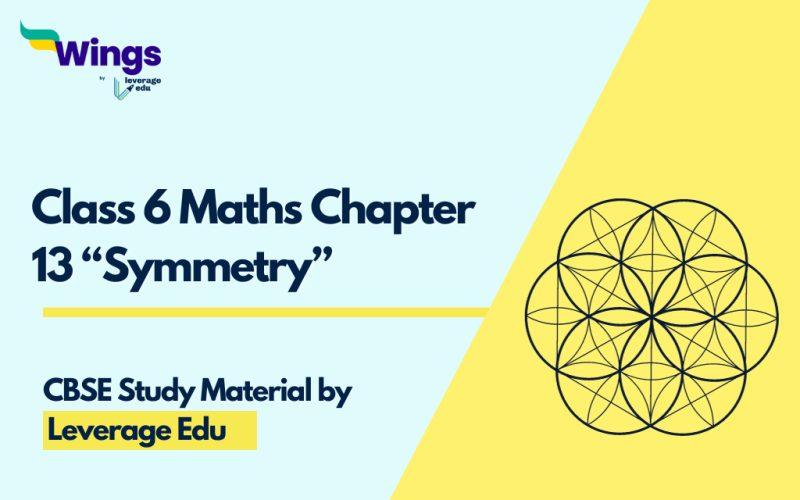In Chapter 13, Symmetry – Class 6, students will be introduced to the concepts of Symmetry. Students will learn to detect symmetry in figures whether they have regular shapes or irregular shapes. The chapter Symmetry, Class 6 teaches the concept of the line of symmetry to students. In the latter stage, students learn to detect symmetry by taking two lines and multiple lines of symmetry within the given shape. At the end of the chapter Symmetry, students learn another means of determining symmetry in various shapes, i.e. by analyzing their mirror reflections. Read through for NCERT Maths Symmetry Class 6 Chapter 13 Notes and Solutions PDF.
Table of Contents
Multiplication and Division Word Problems
Click here to download NCERT Maths Symmetry Class 6 Chapter 13 Notes and Solutions PDF
NCERT Maths Symmetry Class 6 Chapter 13 Notes – PDF Available
Check the topic-wise notes for NCERT Maths Symmetry Class 6 Chapter 13 below. You can also download the PDF of the notes and take a printout to study later when you need quick revision before going to the exam hall.
Top 10 Short Maths Tricks for Complex Problems
Topic 1: Symmetry
When we see certain figures with evenly balanced proportions, we say, “They are symmetrical”.
For example, an earthen pot, the Taj Mahal, a bottle, a butterfly, a mobile phone and so on.
Maths Books for Competitive Exams
BSc Mathematics: Course, Universities and Scope
Topic 2: Line of Symmetry
A line of symmetry divides a solid figure or a shape into two equal and symmetrical halves. A line of symmetry is also called a “mirror line” in some instances.
- Reflection Symmetry: According to the reflection symmetry, if there exists at least one line that divides the given figure or object into two equal halves, then, one of those halves is the reflection of the other half.
NCERT Maths Symmetry Class 6 Chapter 13 – Free PDF Download
Below we have provided solutions for NCERT Maths Symmetry Class 6 Chapter 13. Go through for answers to some important questions.
Exercise 13.1 Solutions
Q 1. List any four symmetrical objects from your home or school.
Solutions. The symmetrical objects present around us are the earthen pots, butterflies, doors and blackboard.
Q 2. For the given figure, which one is the mirror line, l1 or l2?
Solutions. We know that a line of symmetry divides the given figure into two equal and symmetrical halves.
In the given figure, the line l1 does not divide the shape into two equal and symmetrical halves. However, line l2 divides it into equal and symmetrical halves. Therefore, l2 is the mirror line.
Top 20 Career Options in Commerce with Maths Stream
Q 3. In the figure, l is the line of symmetry. Complete the diagram to make it symmetric.
Solutions. We know that a line of symmetry divides the given figure into two equal and symmetrical halves.
∴ the complete diagram would be:

Courses and Career Options in Commerce Without Maths in 2023
Q 4. In the figure, l is the line of symmetry. Draw the image of the triangle and complete the diagram so that it becomes symmetric.
Solutions. The complete symmetric diagram is given below.
Exercise 13.2 Solutions
Q 1. Find the number of lines of symmetry for each of the following shapes.
Solutions. The solutions are given below.
- The given figure contains 4 lines of symmetry as shown below.
- The given figure contains only 1 line of symmetry as shown below.
- The given figure contains 3 lines of symmetry as shown below.
Applied Mathematics and Computation
Check out Maths Class 6 Notes and Exercise Solutions for other chapters below.
FAQs
Ans: When we see certain figures with evenly balanced proportions, we say, “They are symmetrical”. For example, an earthen pot, the Taj Mahal, a bottle, a butterfly, a mobile phone, and so on.
Ans: A line of symmetry divides a solid figure or a shape into two equal and symmetrical halves. A line of symmetry is also called a “mirror line” in some instances.
Ans: According to the reflection symmetry, if there exists at least one line that divides the given figure or object into two equal halves, then, one of those halves is the reflection of the other half.
This was all about NCERT Maths Symmetry Class 6, Chapter 13 in which we studied the use of variables to make certain rules and that mathematical operations can be operated on variables when we need to determine an unknown value for a given quantity. Download the NCERT Maths Symmetry Class 6 Notes and Exercise Solutions to ace your exam preparations. Follow the CBSE Class 6 Maths Notes for more such chapter notes and important questions and answers for preparation for CBSE Class 6 Maths.
 One app for all your study abroad needs
One app for all your study abroad needs













